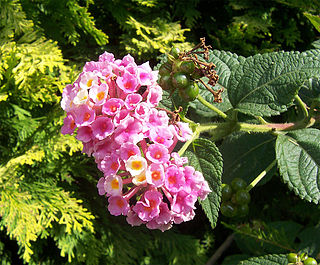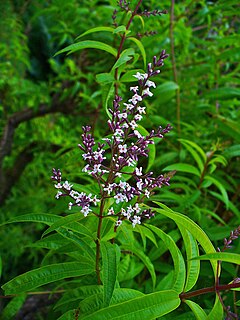
The Verbenaceae — the verbena family or vervain family — are a family of mainly tropical flowering plants. It contains trees, shrubs, and herbs notable for heads, spikes, or clusters of small flowers, many of which have an aromatic smell.

Ponginae, also known as the Asian hominids, is a subfamily in the family Hominidae. Once a diverse lineage of Eurasian apes, the subfamily has only one extant genus, Pongo (orangutans), which contains three extant species; the Sumatran orangutan, the Tapanuli orangutan and the Bornean orangutan. All three species are listed as critically endangered by the International Union for Conservation of Nature (IUCN).

Aloysia citrodora, lemon verbena, is a species of flowering plant in the verbena family Verbenaceae, native to South America. Other common names include lemon beebrush. It was brought to Europe by the Spanish and the Portuguese in the 17th century and cultivated for its oil.

Maria Aloysia Antonia Weber Lange was a German soprano, remembered primarily for her association with the composer Wolfgang Amadeus Mozart.
The Agag gerbil is distributed mainly in southern Mauritania to northern Nigeria and Sudan. IUCN lists the junior synonyms Gerbillus cosensi and G. dalloni as critically endangered.

Lippia is a genus of flowering plants in the verbena family, Verbenaceae. It was named after Augustus Lippi, (1678-1705), a French naturalist and botanist. He was killed in Abyssinia. The genus contains roughly 200 species of tropical shrubs that are found around the world. Plants are fragrant due to their essential oils, which vary between species but may include estragole, carvacrol, linalool, or limonene. The leaves of certain species, such as L. graveolens, can be used as a culinary herb similar to oregano.

A species that is extinct in the wild (EW) is one that has been categorized by the International Union for Conservation of Nature as known only by living members kept in captivity or as a naturalized population outside its historic range due to massive habitat loss.

Kemp's gerbil is a species of rodent. Mammal Species of the World considers G. kempi and G. gambianus to be synonyms, however the IUCN has assessed each taxon as were they different species.

The gracile naked-tailed shrew is a species of mammal in the family Soricidae. It is found in Burundi, Gabon, Kenya, and Uganda. Its natural habitat is swamps.

The Ugandan lowland shrew is a species of mammal in the family Soricidae. It is found in Kenya and Uganda. Its natural habitats are subtropical or tropical swamps and subtropical or tropical moist montane forest. It is threatened by habitat loss.

Babault's mouse shrew is a species of mammal in the family Soricidae found in Burundi, the Democratic Republic of the Congo, and Uganda. Its natural habitat is subtropical or tropical moist montane forests. It is threatened by habitat loss.

The Mount Cameroon forest shrew is a species of mammal in the family Soricidae endemic to Cameroon. Its natural habitat is subtropical or tropical moist montane forests.
The mud catshark or brown catshark is a species of catshark in the family Scyliorhinidae. It is found in Mozambique and Somalia. Its natural habitat is the open seas of the western Indian Ocean, from Mozambique to Somalia, between latitudes 13° N and 29° S, at depths between 340 and 765 m. It can grow up to 34 centimetres (13 in) long.

Aloysia is a genus of flowering plants in the verbena family, Verbenaceae. They are known generally as beebrushes. They are native to the Americas, where they are distributed in temperate climates, as well as in subtropical and desert climates. The genus is named for Maria Luisa of Parma (1751-1819), wife of King Charles IV of Spain.

Helicia is a genus of 110 species of trees and shrubs, constituting part of the plant family Proteaceae. They grow naturally in rainforests throughout tropical South and Southeast Asia, including India, Sri Lanka, Indochina, Peninsular Malaysia to New Guinea and as far south as New South Wales.

The World's 25 Most Endangered Primates is a list of highly endangered primate species selected and published by the International Union for Conservation of Nature (IUCN) Species Survival Commission (SSC) Primate Specialist Group (PSG), the International Primatological Society (IPS), Global Wildlife Conservation (GWC), and Bristol Zoological Society (BZS). The IUCN/SSC PSG worked with Conservation International (CI) to start the list in 2000, but in 2002, during the 19th Congress of the International Primatological Society, primatologists reviewed and debated the list, resulting in the 2002–2004 revision and the endorsement of the IPS. The publication was a joint project between the three conservation organizations until the 2012–2014 list when BZS was added as a publisher. The 2018–2020 list was the first time Conservation International was not among the publishers, replaced instead by GWC. The list has been revised every two years following the biannual Congress of the IPS. Starting with the 2004–2006 report, the title changed to "Primates in Peril: The World's 25 Most Endangered Primates". That same year, the list began to provide information about each species, including their conservation status and the threats they face in the wild. The species text is written in collaboration with experts from the field, with 60 people contributing to the 2006–2008 report and 85 people contributing to the 2008–2010 report. The 2004–2006 and 2006–2008 reports were published in the IUCN/SSC PSG journal Primate Conservation,, since then they have been published as independent publications.














